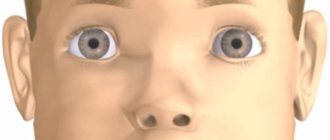An ophthalmologist is a specialist in the field of diagnosis, treatment and prevention of diseases of the visual organs. His competence includes any pathologies, disorders and disorders of the human visual system. Consultation with a doctor is necessary for both children and adults. Regular preventive visits to an ophthalmologist help to avoid the occurrence of eye health problems, and if they exist, to identify them in the early stages, making the chances of successful treatment as high as possible. The particular danger of eye diseases is that in some cases they can cause complete loss of vision, which is why the medical activity of an ophthalmologist (also called an ophthalmologist) is of significant value.
Today, in some medical institutions you can find an ophthalmologist, in others - an ophthalmologist, and given that both doctors treat the eyes, this fact is confusing for patients. When should you see an ophthalmologist, and what does an ophthalmologist do?
Ophthalmologist and ophthalmologist: what are the differences?
The word “ophthalmologist” is of Latin origin: oculus means “eye”. “Ophthalmology” is literally translated from ancient Greek as “the science of the eyes” (“ophthalmos” - eye, “logos” - science). Therefore, from the point of view of the etiology of the terms, they are synonyms.
Content:
- Ophthalmologist and ophthalmologist: what are the differences?
- The science of ophthalmology is the specialization of an ophthalmologist
- What does an ophthalmologist do?
- When to see an ophthalmologist
- Pediatric ophthalmologist
- General rules for preparing for an appointment with an ophthalmologist
- Treatment and diagnostic methods
So, what do an optometrist and an ophthalmologist do? Both doctors specialize in eye pathologies and diseases. There are different opinions among patients about the difference in the competence and qualifications of these doctors, for example, that they are different specialists, that the ophthalmologist has a lower level of qualification, or that both of these doctors are engaged in the same medical practice.
In fact, both names are synonymous and mean the same medical specialization. An optometrist and ophthalmologist treat vision problems. The difference in names is mainly due to the fact that both words originated from different languages. It is also a misconception that an ophthalmologist specializes in conservative treatment methods, while an ophthalmologist performs surgical operations.
In Western European countries, the name “ophthalmologist” is not used, but the terms “ophthalmology” and “ophthalmologist” are used, while in the countries of the former USSR and Eastern Europe the habit of using the word “ophthalmologist” has remained, at least at the everyday level. However, when referring to official documentation and various qualification characteristics, one can find precisely the title “ophthalmologist”.
In some private clinics and medical institutions, advertisers use stereotypes that, supposedly, ophthalmologists who see in other clinics and hospitals are less experienced doctors, and you can only get qualified medical care in a specific private medical institution, namely from an ophthalmologist who has knowledge a large amount of knowledge. In fact, this is not true.
The difference in qualifications occurs only when we are talking, for example, about an ophthalmologist surgeon and an ophthalmologist-oncologist.
Eyesight check
You can have your vision checked by an ophthalmologist by visiting a local clinic or a paid ophthalmology hospital.
Diagnostics usually includes the following:
- checking visual acuity using special tables (for example, Sivtsev, Golovin, Orlova);
- study of eye refraction using optical lenses and refractometry.
Golovin
Sivtseva
Orlova (children's)
Be sure to read the article on when to wear glasses on our website.
The science of ophthalmology is the specialization of an ophthalmologist
All the doctor’s activities relate to the field of ophthalmology. This science has a long history: people first began studying the anatomy of the eye back in the 1st century BC. It was then that the first works describing the anatomy of the organs of vision appeared: the anterior and posterior ocular chambers, the iris and the ciliary body were described. Over the several thousand years of its existence, the medical field has advanced so much that today you will not surprise anyone with highly precise and complex operations such as cornea transplants and laser vision correction, which are carried out using various instruments.
There are several types of division of ophthalmology as a branch of medicine, the main one of which implies the existence of:
- clinical;
- operational;
- emergency ophthalmology.
The clinical section deals with the study and development of methods for conservative treatment of diseases of the organs of vision. The concept of operative ophthalmology includes all processes associated with preparation for eye surgeries, their implementation, and the rehabilitation period after surgery. Emergency ophthalmology deals with acute disorders and pathologies of the visual organs, such as retinal detachment, corneal burns, and eye injuries.
What does an ophthalmologist do?
The first thing an ophthalmologist begins when accepting a patient is conducting a survey and examination of the person who contacted him. After listening to the patient’s complaints, the doctor usually asks clarifying questions in order to more fully paint a picture of the appearance of disturbing symptoms in order to make a correct diagnosis. Next, the doctor conducts an external eye examination.
External inspection is usually carried out according to the following scheme:
- peripheral vision test;
- examining the eyelids for swelling, swelling, peeling and redness;
- examination of the condition of the eyeball and cornea;
- checking the reaction of the pupils to light.
However, the specificity of diagnosing eye diseases lies in the fact that, firstly, only the eyelids and sclera of the eyeballs can be subjected to external examination without the use of special equipment, while most of the visual apparatus is hidden in the skull. Secondly, many eye diseases have symptoms similar to pathologies of the nervous system, brain diseases, acute infectious diseases and other health disorders. In order to determine what problem the patient is forced to seek help with, the doctor conducts a specialized examination using various devices.
So, for example, in the ophthalmologist’s office you can find:
- tables for determining color perception;
- automatic refractometer;
- electric ophthalmoscope;
- diaphanoscope;
- exophthalmometer;
- binocular ophthalmoscope with forehead fixation for reverse ophthalmoscopy;
- automatic pneumotonometer;
- Maklakov applanation tonometer and other devices.
The inner surface of the eye is examined using a special microscope. The doctor examines the blood vessels, checking for damage, cataracts and tumor formations. An ophthalmoscope helps the doctor examine the optic nerve, retina, and muscles surrounding the eye.
For diagnostic purposes, the doctor measures intraocular pressure, determines visual acuity, examines the retina and measures the thickness of the cornea.
After an initial examination and diagnosis, the ophthalmologist decides on the need for inpatient treatment or surgery. If such treatment measures are not needed, the doctor develops a conservative treatment regimen, prescribes drug therapy, special exercises or procedures.
In addition, an ophthalmologist is responsible for conducting preventive examinations in adults and children, providing consultations to prevent the occurrence of eye diseases, and, if necessary, developing and prescribing rehabilitation measures for patients who have undergone surgery or other types of treatment.
Organs and parts of the body that are treated by an ophthalmologist
This doctor is responsible for the health of the visual organs. Anatomically, this system is represented by:
- eyeball;
- over the centuries;
- eye sockets;
- conjunctiva;
- lacrimal organs.
Accordingly, it is these organs that the ophthalmologist treats. Some pathologies of the optic nerve may also fall under his competence, and, in some cases, they are also dealt with by a neurologist.
Diseases and injuries treated by an ophthalmologist
All health problems that fall under the competence of an ophthalmologist are divided into two large groups. The first includes visual impairments that manifest themselves as symptoms of other diseases:
- hypertension;
- pathologies during pregnancy;
- atherosclerosis; disorders of the kidneys;
- diabetes mellitus;
- pancreatitis;
- obesity.
The second group is precisely diseases of the visual organs. Among them:
- Inflammatory process on the mucous membrane of the eye (conjunctivitis).
- Chronic inflammation of the mucous membrane (trachoma).
- Stye is a painful, dense formation with purulent contents on the inner edge of the eyelid.
- Myopia, myopia, is a vision disorder in which it is impossible to fully see objects located at a considerable distance.
- Farsightedness is a vision defect that makes it difficult to see objects up close normally.
- Cataracts (clouding of the eye lens), and glaucoma (increased intraocular pressure). Both disorders lead to decreased visual acuity.
- Color blindness is a disease in which the color perception of surrounding objects is impaired.
- Blepharitis is an inflammatory process of the lower and upper eyelids, expressed in swelling, redness of tissue, and the release of cloudy fluid from cracked eyelids.
- Blindness caused by various factors and visual injuries of varying severity.
In addition, the doctor diagnoses and treats hemophthalmos, amblyopia, astigmatism, nystagmus, leukoma, strabismus and spring catarrh (seasonal exacerbation of conjunctivitis), eye injuries caused by foreign objects or mechanical impact, shock, friction, pressure.
Causes of eye diseases
In the modern world, the role of digital and computer technologies in our lives cannot be underestimated. Unfortunately, not everything is as good as it seems. Computers, tablets and other gadgets can sharply reduce vision, which negatively affects the usual course of life and well-being. An ophthalmologist will help make the correct diagnosis and prescribe appropriate treatment.
Circumstances of deterioration of eye health:
- unfavorable environmental conditions can also lead to unpleasant symptoms of visual impairment;
- poor metabolism in the body only contributes to eye diseases;
- bad habits reduce visual acuity;
- lack of vitamins and minerals;
- stress;
- head injuries;
- various diseases, both infectious and non-infectious.
Main eye diseases:
- myopia affects people of all ages;
- astigmatism - with this disease, the clarity of the objects in question is disrupted;
- farsightedness usually appears with age;
- Chalazion is a neoplasm that appears under the eyelid, mainly under the upper one. Inflammation can also spread to the tissues surrounding the eye.
- dry eye - insufficient hydration of the cornea and conjunctiva, expressed in a feeling of burning and stinging in the eyes;
- stye is caused by infection and requires complex treatment;
- cataract - clouding of the lens is almost impossible to prevent, you can only slow it down;
- macular degeneration leads to blindness due to damage to the retina;
- conjunctivitis - damage to the mucous membrane, possibly redness and purulent discharge;
- color blindness is a violation of human color perception, a congenital defect;
- scleritis - inflammation of the fibrinous membrane of the eyeball, caused by autoimmune pathologies;
- blepharitis - inflammation of the eyelid, manifests itself in the form of redness, peeling of the eyelids and sticking of eyelashes;
- retinal dystrophy is a whole group of diseases characterized by impaired light perception.
When to see an ophthalmologist
There are several groups of reasons for visiting a doctor. Firstly, experts recommend undergoing a preventive examination with an ophthalmologist once a year. The doctor must check visual acuity, examine the fundus, and measure eye pressure. These general measures make it possible to detect possible visual impairments in the early stages, if any, and also to monitor the overall dynamics of changes in a person’s vision. Adults over 40 years of age and children need to undergo such examination more often - once every six months. The same requirements apply to those who suffer from diabetes and high blood pressure, as well as to people who wear glasses and contacts.
Secondly, there are reasons when you need to contact an ophthalmologist urgently. Symptoms that require consultation with a doctor:
- blurred vision;
- involuntary lacrimation;
- pain syndromes of any nature, as well as sensations of dryness, burning, irritation, heaviness;
- the presence of redness of the eyelids or eyeball;
- blurriness of objects near or far when trying to see them;
- pain when trying to look at light (photophobia);
- feeling of the presence of a foreign object;
- the occurrence of blurred vision.
Pediatric ophthalmologist
The first examination by an ophthalmologist in a baby’s life occurs when he reaches two months. During the first years of a child’s life, scheduled visits to an ophthalmologist are a mandatory rule for parents, because it is during this period that the child’s visual system is formed, in addition, in childhood it is easier to identify and treat congenital vision pathologies. Until the age of 12-14 years, the formation of the visual organs occurs, so preventive examinations during this period should be carried out once every six months.
A routine examination of a child by an ophthalmologist allows one to detect the early stages of the development of such ailments as glaucoma, strabismus, decreased vision, and disturbances in the functioning of the eye muscles. During this examination, special drops are used that are harmless to children.
Premature babies have a high risk of developing retinopathy - due to this disease, the child can completely lose his vision. Therefore, for children born before 34-36 weeks, the first visit to the ophthalmologist occurs at the age of 1-1.5 months. The following examinations occur every 2 weeks until the baby is 3-5 months old, unless the ophthalmologist decides that constant visits to the doctor are necessary further.
This type of test, such as examining the fundus of the eye and studying the eye’s reactions to movement, provides the doctor with information that may later be useful to another specialist - a pediatric neurologist.
Before a child enters kindergarten or school, an examination by an ophthalmologist is a mandatory routine procedure for a general medical examination.
As for the indications for urgent unscheduled examinations, among them, first of all, foreign objects, debris, debris, and dust getting into the eyes. Other symptoms parents should watch out for:
- incomplete closure of one or both eyes;
- the appearance of barley;
- obvious squint;
- disappearance of the reflex to move the gaze behind objects located at a distance of approximately 20 cm from the child’s face;
- soreness, photophobia, itching and burning in the eyes;
- involuntary lacrimation;
- constant squinting of the eyes;
- eye or head injuries;
- swelling, itching and redness of the eyelids;
- the appearance of “flies”, “lightning” or rainbow circles before the eyes.
Such manifestations are indications for an urgent visit to an ophthalmologist.
It is in childhood that it is easiest to correct many disorders: diseases of accommodation (presbyopia, accommodation spasm, farsightedness, myopia, astigmatism, accommodative asthenopia).
A rather dangerous situation is when a baby sees normally in one eye, but poorly in the other. In this case, the entire load falls on the healthy eye, due to which strabismus and other pathologies can develop.
If a child is diagnosed with astigmatism or farsightedness, untimely prescription of corrective glasses may cause irreparable vision problems in the future.
It is also important to understand that full diagnostics and consultation of the visual organs can only be carried out by an ophthalmologist (ophthalmologist), in a medical office with all the necessary equipment. Advertising gimmicks of optical stores that entice customers with free diagnostic and treatment measures as part of the selection of optics cannot be considered a full-fledged consultation with a doctor.
General rules for preparing for an appointment with an ophthalmologist
First of all, you need to systematize all your symptoms and complaints in order to clearly and thoroughly describe them to the doctor. It makes sense to take the results of tests and examinations that were done no earlier than half a year before the scheduled examination with an ophthalmologist. Women should not wear cosmetics when going to the doctor. For those who wear contacts, they should be removed at least an hour before your appointment, and in general, if possible, it is best to temporarily switch to glasses about a week before your doctor's appointment.
For children
According to WHO, about 20% of preschool children suffer from eye diseases. Every 4 children have visual impairment. Children suffering from eye diseases and visual impairment cannot develop normally physically and this significantly worsens the quality of life.
It is very important to remember that the health of the child should be in the first place for the parents. Due to the growth of modern digital technologies, the health of a child's eyes is at risk.
A visit to a specialist is now simply a big necessity, which can prevent a number of many unpleasant diseases and help maintain the baby’s sharp vision for a long time.











